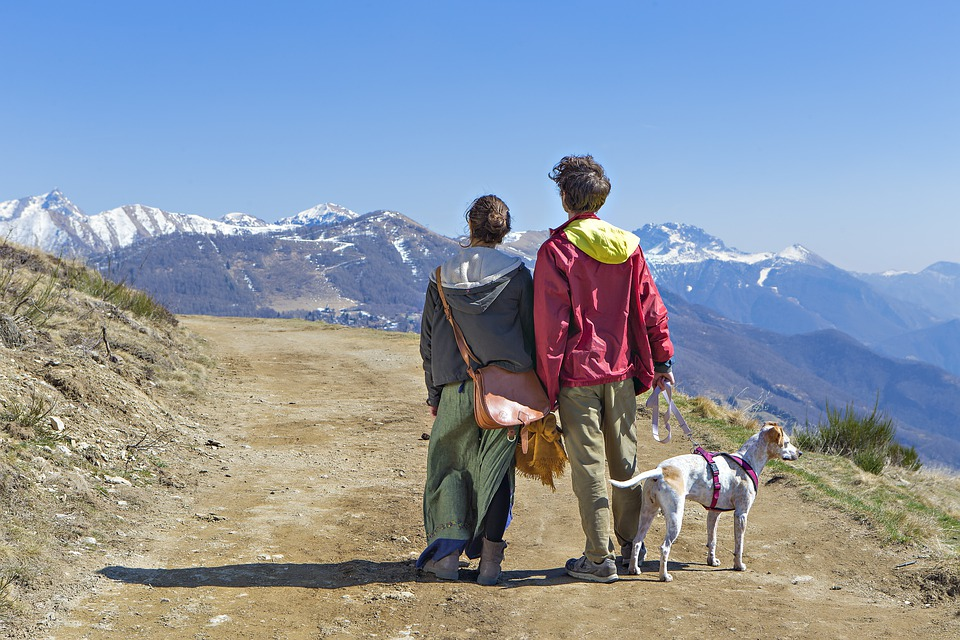Travel Tips
7 Challenges You Face While Traveling With Partner
Published
4 years agoon

Doing things together with your partner is an amazing way to rediscover yourselves and get to understand each other more. However, sometimes, there happen to be quite a few disagreements based on preferences and convenience. But have you thought what could happen when you travel with your significant other? Will it be an amazing adventure or a nightmare?
To clear the air, traveling together can be wonderful for both of you. Like any other day you do things together, you can come across various challenges during the trip. That will, however, not make the trip a nightmare. Things you can solve together can help you build stronger bonds in your relationship. If you have never traveled with your lover before, you should at least try it.
These are seven of the most common challenges you can expect while on a trip with your partner.
1. Differences in Handling Travel Inconveniences
While planning a trip together, you will have an itinerary of favorite places to visit and things to do there. When the day arrives, things do change. Sometimes, you are forced to change direction or opt for a different activity. That can be an easy decision if you are traveling alone. But things are very different if you are out with your partner.
Natural conditions, regulations, and personal inadequacies can hinder you from achieving all that you planned for the trip. While one can be okay with anything that comes and enjoy the trip, the other will be wondering why they ever left home. For them, changed schedules, timelines, and places of interest is a complete ruin on their journey.
To avoid stress, you should discuss from home about the expectations, realities, and occurrences that can change the course of the trip. Tell your partner that things can change along the trip. Let them understand that it is okay if the planned events are canceled as long as you can do other things together.
For example, when you find that the number of people attending an activity is restricted (especially during the present challenge around the world), you can have a private picnic in the park and enjoy your moments together.
2. How You Spend Your Vacation
While at home, both of you wake up before 4 am to grab a mug of coffee and begin your daily routines. Both of you are busy trying to make something to sustain you. Waking up early and sleeping late is the order of the day. Nobody wants to be fired for sleeping till 8 am or missing the train to the office.
Life during a vacation is pretty much different. No alarm clock, no train to catch, no pressing duties. It is time to relax, have fun, and explore. However, two people cannot have the same mindset. One will want to wake up early and prepare for the day’s activities. The other one will want to spend more time sleeping to compensate for the time they don’t get enough sleep.
The difference here can bring a misunderstanding that can make the trip awful if you end up in an argument. Knowing what you are after before leaving is essential. Before you set out on a trip, agree on the various activities that you can participate in. If you want to spend more time sleeping, choose activities that you can attend at a convenient time and do not close too early. You can also decide to entertain yourselves in the room instead of spending long hours at cinemas and clubs after dusk.
3. It Might Be Irritating to Be Together

This might be the worst part to read in this piece. You have been spending most of your time at your workplace and meet your partner in the evenings. You talk for a short time and sleep, waiting for another tedious day. That is how time flies, and you rarely recognize each other’s flaws. Maybe only some small disagreements that come along the things you use at home.
Traveling together is a completely different story. You are going to spend time with your spouse 24 hours a day, all the days until you return from the vacation. I can only imagine how much you are going to learn some flaws about them, which have been a secret all along. The problem is not knowing that your spouse can be annoying. Standing there and watching them get into your nerves is the uphill task.
Tolerance is a policy that can help both of you to stay together and enjoy the vacation. However, you should freely express to each other and draw clear lines about what you do not like so that your partner can watch his or her steps. In the same way, you may want to sacrifice a few things to offend your partner.
4. Not Having Same Interests
If you have never traveled with others before, you are going to be surprised. If you were thinking that traveling as a team or with your partner will be the most amazing adventure doing everything together, you will discover that there is a big difference between expectations and reality. You may have very many things in common, but when it comes to favorite activities, you are far apart.
While you may love surfing, your partner would be so much into hiking. These two adventures take place in different environments, and you cannot participate together and at the same time. That means that sometimes you will be far away from each other for most of the day.
While planning your adventure trip, you should table each activity you are interested in. If your interests differ so much, you may want to rethink the trip. Either you decide to engage in the other’s activities to learn a new adventure or you only opt to attend events that both of you have interest in.
5. Unpreparedness for the Trip
Sometimes it is wonderful to plan a surprise for your partner. It is one of the best ways to spice up a relationship or friendship. However, some surprises may not be received with gladness. Travel is one area where you need to plan well in advance and avoid so many inconveniences during the trip.
If you tell your partner that you are going on a trip in three days after booking everything, you may be turned down and lose your money. Your friend needs to prepare as much as possible for the trip. They need time to get the best gear they need on the trip and plan on rescheduling their duties so that they have enough time to travel with you. Make sure you prepare them early enough, maybe two or three months in advance.
6. Breaking the Budget

Traveling is associated with many expenses. If you are not careful, you can spend far too much on your credit card on a trip. With so many amazing events and activities and an unending list of to see, you can easily forget how much you are supposed to spend in various parts of the world.
Traveling with a partner will not be cheaper. You might want to impress her or him by buying a gift during the trip. One problem with buying items abroad is that you will encounter higher prices because the sellers know that tourists have some money to spend. Going to the market places in the city might not be a good idea either. While you can get more affordable items, you may end up in the hands of pick-pockets.
While you may want to spend on some necessary items and entertainment, you should be aware of the budget you have so that you do not spend beyond the limits. Credit cards can help you pay for as many items as you may want, but remember that they charge a high interest rate and pay them as soon as possible. Such spending habits can put you in a loop of debts and financial constrictions.
Create a clear budget of all the things you are going to spend while on the trip, then set apart some allowance for emergencies. That will help you to restrain yourself from spending way too much. Remember to walk with your to-do list to avoid unnecessary expenses on things you never anticipated. Carry all the gear you need on the trip on the roof rack to avoid buying or hiring things along the way.
7. Spending Alone Time
It is normal to wake up feeling abnormal. Moods do change due to various reasons, some of which are unexplainable. That is when you feel like keeping to yourself and spending your time alone doing nothing. Maybe a good rest and diet can help you to recover and get the vibes you need to take on another adventure.
Traveling with a team or friend can be inconvenient because such moments can ruin team experiences. Going out without the moods will be a waste of time. At the same time, your partner may not want to do things alone when you planned to be together. It is essential to avoid booking for adventures in advance. Only engage in something when you feel okay for the same.
Summing Up
Traveling can be an awesome experience. At the same time, however, you should expect some inconveniences when traveling with a partner. Fortunately, everything has a solution. The aim of traveling together is to spend time together and get the most out of your adventures. When challenges emerge, you can solve them and continue with the plans.
Cole is one half of New Zealand's leading adventure travel blogging couple who have been wearing out their jandals around the world since 2009. He loves any adventure activities and anything to do with the water whether it is Surfing, Diving, Swimming, Snorkeling or just lounging nearby on the beach. You can follow Cole on Google+. Or consider following us via RSS Feed, Twitter, Facebook and subscribe to our Newsletter.

You may like
Travel Tips
How Travel Can Help Clarify Romantic Intentions and Prevent Ambiguous Relationships
Published
1 month agoon
June 12, 2024
Travel Synchronicity and Its Impact on Relationships
The concept of traveling synchronicity plays a crucial role in how romantic getaways are experienced. Studies indicate that when travel plans and expectations are well-aligned between partners, it enhances the overall experience. A harmonious trip results from the absence of misunderstandings, which can be achieved through effective communication of travel plans.
Academic research has highlighted this phenomenon, revealing that a coherent travel plan among partners leads to fewer misunderstandings. Ensuring that both partners agree on destinations, schedules, and activities mitigates the risks of conflicts during the trip. This harmonious planning process significantly contributes to a more enjoyable and less stressful travel experience for both individuals involved.
Clarity in Travel Intentions
Travel intentions play an instrumental role in the quality of a romantic trip. Researchers studying potential and repeat visitors’ travel intentions identified that destination image mediates the relationship between travel motivations and travel intentions. This means that the perception of a destination influences a person’s travel decisions and the purpose behind them.
Teresa Wu’s exploration on the topic, as detailed in her article “What are your travel intentions?”, underscores the relevance of pinpointing the primary objectives or goals of a trip. This methodology aids couples in organizing their activities and optimizing their time and resources. Clear travel intentions ensure that couples can effectively focus on shared goals, whether those are relaxation, exploration, or spending quality time together.
A further examination reveals that online interactions significantly influence travel intentions. A study of Tinder users during the COVID-19 pandemic found that individuals who disclosed more about themselves were more likely to plan future travels. This indicates a link between online self-disclosure and subsequent travel intentions, underscoring the role of transparent communication even before the actual travel process begins. This is particularly relevant in romantic contexts where understanding each other’s preferences and expectations can prevent ambiguity.
Communication, Trust, and Intimacy
Effective communication, trust, and intimacy form the pillars upon which travel intentions can be built and clarified. Online dating provides numerous opportunities to connect with a wide range of individuals, from those looking for serious commitments to those wishing to find an SB online, where shared interests and mutual respect are the foundation of the connection. The level of self-disclosure in these interactions can predict travel intentions significantly, suggesting that openness in online communications may translate to clear travel plans and intentions.
Clear communication about travel plans and intentions ensures that both partners are on the same page, which is essential in preventing misunderstandings. Trust and intimacy, developed through transparent conversations, pave the way for shared travel goals. The findings from various studies demonstrate that couples who communicate openly about their travel desires and intentions are more likely to have fulfilling travel experiences.
In practice, establishing a clear set of objectives for a trip helps manage expectations and aligns partners towards common goals. Whether the purpose is relaxation, adventure, or bonding, clarity in travel intentions reduces ambiguity and enhances the overall experience. By focusing on specific travel goals, couples can create itineraries that cater to their mutual desires and foster stronger relationships.
Conclusion
In summary, travel can serve as a clarifying agent for romantic relationships by promoting alignment in travel plans and intentions. The synchronicity in travel arrangements minimizes misunderstandings and contributes to a harmonious trip. Understanding travel intentions, influenced by factors such as destination image and online interactions, further aids in creating cohesive travel experiences. By emphasizing communication, trust, and intimacy, couples can ensure clarity in their romantic intentions, preventing ambiguous relationships and fostering deeper connections.
Travel Tips
Visiting the UK for the First Time? 10 Things to Consider Doing (2024)
Published
5 months agoon
March 10, 2024
Are you planning a trip to the United Kingdom and feeling a little overwhelmed with all there is to do? No worries! The UK is packed with history, culture, and beautiful landscapes, making it an exciting destination for any traveler. To help you get started, here are ten things you should consider doing on your first visit.
1. Explore London’s Iconic Landmarks
London is often the starting point for many visitors, and for good reason. The city is bursting with iconic sights that you’ve likely seen in movies or read about in books. Be sure to check out:
- The Tower of London: Learn about its rich history and see the Crown Jewels.
- Buckingham Palace: Try to catch the Changing of the Guard ceremony.
- The Houses of Parliament and Big Ben: Snap some photos of these famous structures.
- The London Eye: Get a bird’s eye view of the city from this giant Ferris wheel.
Walking along the River Thames will give you a great perspective of the city’s skyline, too!
2. Take a Day Trip to Stonehenge
Just a couple of hours away from London, Stonehenge is a prehistoric marvel that has stood on the British landscape for thousands of years. It’s a UNESCO World Heritage site and one of the most famous landmarks in the UK. Many tours are available that can provide round-trip transportation and insightful commentary about this mysterious stone circle.
3. Discover the Scottish Highlands
If time allows, venture north to Scotland and experience the breathtaking beauty of the Scottish Highlands. With its rugged mountains, serene lochs (lakes), and sweeping glens (valleys), it’s an area of outstanding natural beauty. You might even want to try spotting the elusive Loch Ness Monster while you’re there!
4. Play the Irish Lottery
While exploring the UK, many travelers try their luck with the Irish Lottery. While based in Ireland, the Irish Lotto remains popular in the UK among locals and visitors alike. People can purchase a ticket from authorized retailers like Lottoland.
5. Visit Historical University Towns
The UK is home to some of the world’s most prestigious universities, and the towns of Oxford and Cambridge are well worth a visit. Wander around the historic college buildings, admire the architecture, and maybe even take a punt (boat) down the river. Both towns have a unique charm and are brimming with history and culture.
6. Enjoy Traditional British Cuisine
Your trip won’t be complete without trying some traditional British food. Fish and chips are a must-have, ideally enjoyed by the seaside. Also, don’t miss out on a classic Sunday roast at a local pub, complete with Yorkshire pudding and gravy. For something sweet, afternoon tea is a charming British tradition where you can indulge in scones, sandwiches, and a selection of teas.
7. Wander Through the Lake District
The Lake District is England’s largest National Park and a UNESCO World Heritage site, renowned for its stunning lakes, forests, and mountains. It’s the perfect place for outdoor enthusiasts. Whether you prefer hiking, cycling, or simply picnicking by the water’s edge, the natural beauty here is sure to leave you in awe. Don’t forget to visit the charming villages like Windermere and Keswick.
8. Experience the Welsh Culture in Cardiff
Cardiff, the capital of Wales, offers a blend of ancient history and modern Welsh culture. Explore Cardiff Castle, stroll through Bute Park, or catch a rugby match to experience the national sport and passion of Wales. The city also boasts a vibrant waterfront at Cardiff Bay, where you can find delicious Welsh cuisine and entertainment.
9. Attend a West End Show in London
For theatre lovers, attending a show in London’s West End is a must-do. The area is famous for its high-quality theatrical productions, ranging from musicals and comedies to classic dramas and new works. There’s something magical about spending an evening in one of the historic theatres, enjoying world-class performances that you’ll remember long after the curtain falls.
10. Visit the Giant’s Causeway in Northern Ireland
A trip to the UK wouldn’t be complete without seeing the Giant’s Causeway in Northern Ireland. This natural wonder consists of 40,000 interlocking basalt columns, give or take, resulting from an ancient volcanic eruption. Legend says it was built by giants, and as you walk the coastal path with the Atlantic Ocean crashing beside you, it’s easy to see why this myth persists. It’s a truly unique and unforgettable sight.
Remember, the UK is more than just its sights; it’s the experiences and the people that make a trip truly memorable. So, chat with locals, take in the scenery, and immerse yourself in the culture. Have a fantastic trip!
Content to be used for social media sharing
Did you get receive an inheritance or own the Lottoland’s lottery and are planning a trip to the UK? Here are 10 things to consider doing next time you visit the United Kingdom.
Travel Tips
Exploring Equatorial Guinea: A Journey through the Heart of Africa
Published
5 months agoon
March 6, 2024
Tucked away in the western part of Central Africa lies Equatorial Guinea, a nation often referred to as the “Heart of Africa” due to its geographical location straddling the equator. This small yet captivating country comprises the mainland region called Rio Muni and several islands, with Bioko being the largest and most populous. Exploring Equatorial Guinea is akin to embarking on a journey through a microcosm of Africa’s diverse landscapes, cultures, and history. So, if you are in the mood to plan a trip to this wonderful land, make sure to check out eVisa in order to keep things going easily and plan stress-free.
A Tapestry of Landscapes
Equatorial Guinea’s geography is as varied as it is stunning. From dense rainforests to pristine beaches and volcanic landscapes, this country offers a tapestry of natural wonders waiting to be discovered. The lush rainforests of Bioko Island are a haven for biodiversity, home to rare species such as the drill monkey and the African grey parrot. Hiking through the dense foliage, one can encounter cascading waterfalls, hidden lagoons, and endemic flora that thrive in this ecological paradise.
Venturing to the mainland, Rio Muni unveils a different facet of Equatorial Guinea’s landscape. Here, expansive savannas stretch as far as the eye can see, interrupted by winding rivers and rolling hills. The Monte Alen National Park, a UNESCO Biosphere Reserve, offers intrepid travelers the chance to witness elephants, gorillas, and other wildlife roaming freely in their natural habitat. Explorations along the Rio Muni River reveal traditional villages where ancient customs and traditions are still preserved, providing a glimpse into the rich cultural tapestry of Equatorial Guinea.
Cultural Encounters
Equatorial Guinea is a melting pot of cultures, with influences from indigenous tribes, Spanish colonial heritage, and neighboring African nations. This diversity is reflected in the country’s vibrant music, dance, and cuisine. Traditional rhythms reverberate through the streets during festivals and celebrations, where locals clad in colorful attire showcase their ancestral dances passed down through generations.
The capital city, Malabo, offers a fascinating blend of old-world charm and modernity. Spanish colonial architecture stands side by side with contemporary structures, creating a unique juxtaposition of styles. The bustling markets of Malabo are a feast for the senses, with vendors selling fresh produce, spices, and handicrafts crafted by local artisans. Exploring the city’s museums and galleries provides insight into Equatorial Guinea’s history, from its pre-colonial roots to its struggle for independence and subsequent development.
Island Escapes
Equatorial Guinea’s islands offer a perfect escape for those seeking sun, sand, and sea. Bioko Island boasts pristine beaches fringed by coconut palms, where azure waters beckon travelers to swim, snorkel, and dive amidst colorful coral reefs teeming with marine life. The island’s volcanic peaks provide a dramatic backdrop for exploration, with opportunities for hiking, birdwatching, and even volcano trekking for the adventurous.
Off the coast of Rio Muni lies the tranquil island of Annobón, a secluded paradise untouched by mass tourism. Here, time seems to stand still as visitors immerse themselves in the laid-back island lifestyle, characterized by warm hospitality and breathtaking natural beauty. Snorkeling in crystal-clear waters, exploring hidden coves, or simply unwinding on deserted beaches are among the activities that make Annobón a hidden gem waiting to be discovered.
Conclusion
Exploring Equatorial Guinea is a journey of discovery, where every corner reveals a new facet of Africa’s rich heritage and natural splendor. From the lush rainforests of Bioko to the pristine beaches of Annobón, this small yet diverse country offers endless opportunities for adventure, cultural immersion, and relaxation. Whether you’re a nature enthusiast, a history buff, or simply seeking an off-the-beaten-path destination, Equatorial Guinea promises an unforgettable experience that will leave a lasting impression on all who visit.
Meet Cole and Adela
 We have been wearing out our jandals (Kiwi for flip-flops) on our travel adventures around the world since 2009. We think our blog is thought provoking and a little witty. But we have been proven wrong before. Find out more about us here...
We have been wearing out our jandals (Kiwi for flip-flops) on our travel adventures around the world since 2009. We think our blog is thought provoking and a little witty. But we have been proven wrong before. Find out more about us here...
Find
New on Four Jandals
What Are You Looking For?
- Adventure Travel (235)
- Africa (25)
- Asia (31)
- Auto (2)
- Business (5)
- City Guides (26)
- Entertainment (7)
- Europe (177)
- Food (16)
- Home (4)
- Inspiration (12)
- North America (51)
- Oceania (32)
- Other (219)
- Personal Musings (9)
- Reviews (16)
- Technology (11)
- Travel Blogging Tips (9)
- Travel Tips (282)

